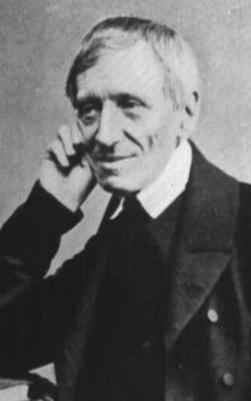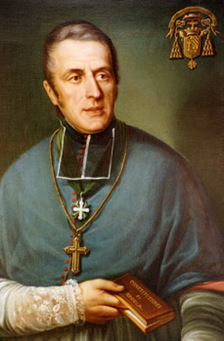Parish History

Saint Anne's is one of the oldest Missions in Birmingham. Founded in 1849 it was given into the charge of the Oratorian Fathers, with John Henry Newman (later Cardinal) as the first parish priest. Born in 1801, in the City of London, he was the eldest son of pious Anglican parents. In the summer of 1832 he went to Rome and visited the English College.
The rector at that time was Nicolas Patrick Wiseman. John Newman left his friends and went to Sicily where he was taken seriously ill. He thought he was going to die and made all the necessary preparations. He really thought and believed that God had a special job for him. He somehow recovered, and on his return journey to England wrote the words of the hymn 'Lead Kindly Light.' On 24th September 1842 John Henry Newman preached his last sermon as vicar of St. Mary's Oxford. He spoke on the 'Parting of Friends' and went into retirement. His companions spent their time in prayer and study. From 1843 to 1845, Newman lived in Littlemore near Oxford. The picture of Newman above is dated 1845, four years before he arrived in Alcester Street. Nicolas Patrick Wiseman had become a Bishop and was now rector at Oscott in Birmingham. On 9th October 1845, quietly and without any fuss, John Henry Newman was received into the Catholic Church by Father Dominic Barberi who was visiting Littlemore.. He was confirmed in the Oscott Chapel on 1st November 1845 by Bishop Wiseman. He was ordained a priest in Rome in May 1847 by Cardinal Franzoni and celebrated his Christmas Mass in London. Soon after Christmas Day he left London for Kingstanding, Birmingham. There, he established his Oratory at Old Oscott, which he renamed Maryvale. Since it should be near crowded centres of population and Maryvale was not even a hamlet, just a cluster of buildings amid some farms, it was closed at the end of 1848. The community and John Henry Newman took up temporary residence at St. Wilfrid's. This later became Cotton College, in North Staffordshire. On leaving St. Wilfrid's, Newman arrived in Alcester Street on Friday 26th January 1849. On 2nd February 1849 John Henry Newman preached at the opening of the new Oratory in Alcester Street which was to be his home for the next three years. Fr. Newman spent some of his time in parish work, but most of his time was spent giving sermons and lectures in Birmingham and elsewhere. This Oratory was a large building in Alcester Street. Formerly a gin distillery, it was bought and fitted up as a Chapel to accommodate five hundred people. It was in this building that John Henry Newman delivered some of his famous sermons on Anglican questions. The failure of the Potato Crop in Ireland, caused the great famine of 1847. Thousands of Irish men and women were forced to leave their native land, in search of work and food in England. Many of them settled in Birmingham and particularly in Deritend. They became the Congregation of John Henry Newman, when he set up his church in the disused Gin Distillery. To this day even though very few dwellings exist around the Church - the majority of the hundreds of Worshippers, are Irish or of Irish descent. St. Anne's Church is totally surrounded by factories, warehouses and office blocks. It still continues (as it has since the famine times) to be a spiritual haven for the Irish. It is interesting to note that the Oblates of Mary Immaculate, took possession of Maryvale House in Kingstanding in May 1849, soon after Newman left for Alcester Street. Maryvale became a Novitiate for the French Oblate Fathers until 28th August 1851. The founder of the Oblate Fathers, Bishop de Mazenod visited Maryvale during that time. He ordained Claude Sallaz to the priesthood on 21st July 1850, Brother Babel and Brother McMonagh to the diaconate, and Brother C.J. Dunne to the sub-diaconate. Eugene de Mazenod died at the age of 79 on 21st May, 1861. The Church canonized him on December 3rd 1995. In 1852 the Oratorians moved to their present destination at Hagley Road, Edgbaston. Fr. Newman worked there. He was made a Cardinal in 1879. At Christmas 1889 he said Mass for the last time. On 10th August 1890 he received the last Sacraments, and on 11th August, having been unconscious most of the day, he died. He was buried at Rednal, Birmingham on 19th August 1890. In 1991, Newman was proclaimed venerable after a thorough examination of his life and work by the Sacred Congregation for the Causes of Saints. One miracle was investigated and confirmed by the Vatican, so he was beatified on 19 September 2010 by Pope Benedict XVI. A second miracle is necessary for his canonisation. Between 1852 - 1859 the parish in Alcester Street was served by Father John Wise and Father Thomas More. In 1859 Fr. John P. Dowling became parish priest. Fr. Dowling, a native of Kilkenny, gave to St. Anne's the fine church that stands today where Alcester Street and Bradford Street adjoin. The old Church (Gin Distillery) became a school, until 1938. Under the guidance of Father Dowling, the whole property from the Church to the priest's house (about ¾ acre) was subsequently acquired, and in due course they determined to build a new Church and to use the existing building (the old Distillery) as a school. The new Church, built in the early English style of architecture, was opened in 1884 by Cardinal Manning. In 1903 Canon Villiers succeeded Fr Dowling. He was born in Birmingham on 2nd March, 1857. He first began his studies at St. Chad's Grammar School, Spring Hill. He then went to the school at Sedgley Park, near Wolverhampton. About that time the school at Sedgley Park was transferred to St. Wilfrid's College, Oakamoor, now known as Cotton College, and the first class sent to the new home included the Canon, also the late Archbishop Keating and Fr. Jones. From Cotton College the Canon went to Douai, in France, to continue his priestly studies, under the Benedictine Fathers. After three years' stay in France, he returned to England, and went to St. Bernard's Seminary at Olton (The Friary, St Bernard’s Road) to study philosophy and theology. It was there he was raised to the Priesthood on 23rd December, 1882. . Canon Villiers began his life as a Missionary Priest at St. Anne's, where he was sent as Curate to Fr. Dowling. During that time the Canon began his correspondence with the local papers. He had been our great protagonist in the Press, and won the admiration of many by his brief, lucid and logical exposition of the Catholic Cause, whether in defence of Catholic schools or Catholic doctrine itself. In 1890 the Canon was sent to take charge of the mission of Willenhall and Darlaston; he remained there for three years. He was then transferred to St. Vincent's Ashted Row. In 1899 the Canon was made Diocesan Inspector of Schools, and this work took him throughout the whole length and breadth of the diocese. In 1903 the Canon was recalled to St. Anne's and appointed Rector. The Archbishop was pleased, in 1917, to honour him by appointing him a Canon of the Metropolitan Chapter. During his residence at St. Anne's, the Canon won the affection of all his parishioners and endeared himself in their hearts. His generosity and kindness to the poor were well known. He had been a wise counsellor to all in their difficulties. 
On a pilgrimage to Lourdes in 1938 the Oblate Provincial, Fr Michael Ryan OMI, was introduced to the Archbishop of Birmingham, Dr Williams. He made it known to His Grace that the Oblates would be very willing to open a house in the Archdiocese of Birmingham if a vacancy occurred. As a result, St Anne's parish was placed in the care of the Oblate Fathers on the death of Canon Villiers on 19th October 1938. The first Oblates arrived in St Anne's on 2nd November 1938. Since that time over 60 Oblate priests and brothers have ministered in this area from St Anne's Church.
The Missionary Oblates of Mary Immaculate were founded in 1816 by St Eugene de Mazenod (1782-1861) Irish Welfare During the 1950s and 60s immigration from Ireland was massive. Very many came to Birmingham. Often they came with no contact, no accommodation and no job. This was a problem for the Irish in Birmingham. The priests at St. Anne's realised the situation and through the Legion of Mary and others, they organised pairs of volunteers to meet the 6.10 am boat train at New Street Station. They were wearing armbands and when they found people with no place to go they brought them first to St. Anne's and later to the Irish Welfare Centre at Moat Row. There they would get something to eat, and the priests would try to find them accommodation and a job. From this beginning the Irish Welfare and Information Centre began to grow into what it is today. St. Anne's Hostel Around St. Anne's there were many, far too many, homeless and inadequate men. One of the priests from St. Anne's, Fr. Paschal Dillon, realised that they needed some sort of decent accommodation. Eventually he found a building at the back of the Paragon Hotel and acquired it for the purpose of feeding and accommodating the homeless. This developed over many years of struggle, and now the social services of Birmingham City Council run it in a very professional way. Oblates who have served at St.Anne’s :
Parish Priests serving St Anne’s:
|